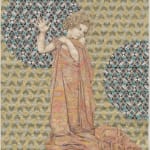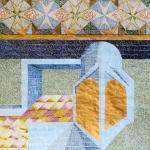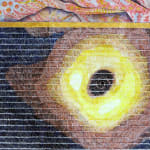

Detail of Columbina by Peter Depelchin, 2020, pen and Chinese ink on silk paper, 100x75cm

Detail of Columbina by Peter Depelchin, 2020, pen and Chinese ink on silk paper, 100x75cm

Detail of Columbina by Peter Depelchin, 2020, pen and Chinese ink on silk paper, 100x75cm

Detail of Columbina by Peter Depelchin, 2020, pen and Chinese ink on silk paper, 100x75cm

Detail of Columbina by Peter Depelchin, 2020, pen and Chinese ink on silk paper, 100x75cm

Installation view of Columbina by Peter Depelchin at Husk Gallery
Peter Depelchin
Further images
Columbina could mistakenly be perceived as a very classical drawing, but it is a layered piece only seemingly giving up all its content. The sheet of paper, divided in four pieces (three equal parts below and one very large part above) evokes the polyptych form of the Italian duecento, especially from painters from the Sienese school as Simone Martini and Pietro and Ambrogio Lorenzetti. In order to meet the high demand of local Tuscan churches and parishes, they invented the predella: small painted frames at the bottom of a polyptych. The large upper panels always consisted of static saints, the holy virgin or Saint John. They could easily be made in big amounts. The predella however is proof of a closer and unique dedication to the local purchaser, the church or the parish. Its narratives are representing tales of lesser known patron saints and miracles.
The predella of “Columbina” exists of three parts; the extreme parts represent small enclosed spaces. As prior series “a Garden” and “Temple de Pan” these spaces were inspired by Persian miniature. Their perspectives, distorted and illusionary, are questioning the connectedness of space and time. Hence does the representation of the black hole in the central part of the predella. The black hole is an oblivion attracting all that is physically observable. The enclosed cloister garden was designed to be an oblivion of thought and a place to contemplate. Moreover, mostly it contained a water well in its center. The water well as source and river mouth can symbolize the black hole and vice versa. Isn’t the black hole a sign of eternal return? Isn’t the black hole the head of the snake biting its own tail?
The young girl of the upper part of the drawing was inspired by a Roman sculpture. While Depelchin resided in Rome at the Academia Belgica, he was confronted with this sculpture at the Musei Capitolini. The original sculpture represents a girl holding a pigeon and since his observation Peter repeatedly drew and interpreted the sculpture. In total he drew four versions: two pencil drawings and two pen and ink drawings. The predella is only featured in this last drawing. Prior drawings show a bar representing the word “Columbina”. Even though Depelchin decided to get rid of the belle-epoque typography of the word “Columbina”, the overall feel of the drawing keeps on being very 19th century. One could even say pre-Raphaelite. Let’s not forget however that “renaissance painting” is Depelchin’s hobbyhorse: cross-references between the upper part and the predella are omnipresent. The background is covered with Arabic motives and the circular forms can be considered as black stars.
Finally, the inspiration Depelchin got from the Sienese school is very valuable. It means another breakthrough in his approach of the correlation between space and figuration. Already being inspired by panoramic cell phone photographs and twisted “divine perspectives” in Eastern and Western miniatures, Depelchin enlarges his toolbox to represent meaning beyond the represented.
- X
- Tumblr








